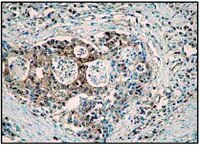NKp46 defines ovine cells that have characteristics corresponding to NK cells.
Timothy Connelley,Anne K Storset,Alan Pemberton,Niall Machugh,Jeremy Brown,Hege Lund,Ivan W Morrison
Veterinary research
42
2001
Show Abstract
ABSTRACT: Natural killer (NK) cells are well recognized as playing a key role in innate immune defence through cytokine production and cytotoxic activity; additionally recent studies have identified several novel NK cell functions. The ability to study NK cells in the sheep has been restricted due to a lack of specific reagents. We report the generation of a monoclonal antibody specific for ovine NKp46, a receptor which in a number of mammals is expressed exclusively in NK cells. Ovine NKp46+ cells represent a population that is distinct from CD4+ and ??+ T-cells, B-cells and cells of the monocytic lineage. The NKp46+ cells are heterogenous with respect to expression of CD2 and CD8 and most, but not all, express CD16 - characteristics consistent with NK cell populations in other species. We demonstrate that in addition to populations in peripheral blood and secondary lymphoid organs, ovine NKp46+ populations are also situated at the mucosal surfaces of the lung, gastro-intestinal tract and non-gravid uterus. Furthermore, we show that purified ovine NKp46+ populations cultured in IL-2 and IL-15 have cytotoxic activity that could be enhanced by ligation of NKp46 in re-directed lysis assays. Therefore we conclude that ovine NKp46+ cells represent a population that by phenotype, tissue distribution and function correspond to NK cells and that NKp46 is an activating receptor in sheep as in other species. Full Text Article | 21345198
 |














